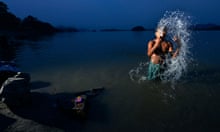The Ganges river, considered sacred by more than 1 billion Indians, has become the first non-human entity in India to be granted the same legal rights as people.
A court in the northern Indian state of Uttarakhand ordered on Monday that the Ganges and its main tributary, the Yamuna, be accorded the status of living human entities.
The decision, which was welcomed by environmentalists, means that polluting or damaging the rivers will be legally equivalent to harming a person.
The judges cited the example of the Whanganui river, revered by the indigenous Māori people, which was declared a living entity with full legal rights by the New Zealand government last week.
Judges Rajeev Sharma and Alok Singh said the Ganges and Yamuna rivers and their tributaries would be “legal and living entities having the status of a legal person with all corresponding rights, duties and liabilities”.
The court in the Himalayan resort town of Nainital appointed three officials to act as legal custodians responsible for conserving and protecting the rivers and their tributaries. It ordered that a management board be established within three months.
The case arose after officials complained that the state governments of Uttarakhand and neighbouring Uttar Pradesh were not cooperating with federal government efforts to set up a panel to protect the Ganges.
Himanshu Thakkar, an engineer who coordinates the South Asia Network on Dams, Rivers and People, said the practical implications of the decision were not clear.
“There are already 1.5bn litres of untreated sewage entering the river each day, and 500m litres of industrial waste,” he said.
“All of this will become illegal with immediate effect, but you can’t stop the discharge immediately. So how this decision pans out in terms of practical reality is very unclear.”
Indian courts have been critical of three decades of government efforts to clean up the Ganges, a 2,500km waterway named after the Hindu goddess Ganga. The latest cleanup initiative has set 2018 as its deadline, one that water ministry officials have reportedly conceded is unlikely to be met.
Thakkar said Monday’s decision could be an effort by courts to broaden their scope for intervention in the river’s management. “[The] government has been trying to clean up the river by spending a lot of money, putting in a lot of infrastructure and technology, but they aren’t looking at the governance of the river,” he said.
He gave the example of the Yamuna, which is monitored by 22 sewage treatment plants in Delhi. “But none of them are functioning according to their design in terms of quantity and quality, and we don’t know the reason,” he said.
“You need a simple management system for each of the plants and give independent people the mandate to inspect them, question the officials and have them write daily and quarterly reports so that lessons are actually learned.”
Environmental activists say many rivers in India have become dirtier as the economy has developed, with city sewage, farming pesticides and industrial effluents freely flowing into waterways despite laws against polluting.
The Yamuna is the main tributary of the Ganges that officials say is tainted with sewage and industrial pollution. In some places, the river has stagnated to the point that it no longer supports life. Water from the Yamuna is treated chemically before being supplied to Delhi’s nearly 19 million residents as drinking water.
In New Zealand, the local Māori iwi, or tribe, of Whanganui in the North Island had fought for the recognition of their river – the third largest in New Zealand – as an ancestor for 140 years.
Last Wednesday, hundreds of tribal representatives wept with joy when their attempt to have their kin awarded legal status as a living entity was passed into law.
“We have fought to find an approximation in law so that all others can understand that, from our perspective, treating the river as a living entity is the correct way to approach it, as an indivisible whole, instead of the traditional model for the last 100 years of treating it from a perspective of ownership and management,” said Gerrard Albert, the lead negotiator for the iwi.








